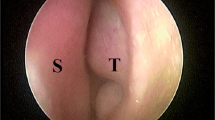Abstract
To evaluate the efficacy of diode laser turbinate reduction procedure in treatment of symptomatic inferior turbinate hypertrophy (ITH) and to study the effect of it on mucociliary clearance of nose. This prospective study was carried out over 45 patients with symptomatic ITH refractory to medical management from July 2009 to March 2010 in Department of E.N.T, Jawaharlal Institute of Post Graduate Medical Education and Research, Pondicherry, India. Each symptom (nasal obstruction, rhinorrhoea, sneezing, headache, hyposmia and snoring) was assessed by visual analogue scale (VAS). Mucociliary clearance was measured by saccharin transit time (STT). All patients underwent diode laser turbinate reduction (LTR) under local anesthesia. The patients were followed up at 1 week, 1, 3 and 6 months postoperatively. During each follow up visit, symptoms were reassessed by VAS score. Difference between preoperative and postoperative VAS score was statistically significant. All patients had significant symptomatic improvement which started from 1 week postoperatively and persisted throughout the follow up period. Prolongation of STT following diode laser turbinate reduction was significant. SST returned back to preoperative value by the end of 6 months. Crusting and pain were the main postoperative complaints. Diode laser turbinate reduction is safe, minimally invasive and effective in relieving the symptoms associated with ITH and can be performed on a day care basis under local anaesthesia. Longer follow up is required to assess the development of late complications and recurrence of symptoms after LTR.
Similar content being viewed by others
References
Janda P, Sroka R, Betz CS, Grevers G, Leunig A (2002) Ho:YAG and diode laser treatment of hyperplastic inferior nasal turbinates. Laryngorhinootologie 81:484–490
Cavaliere M, Mottola G, Iemma M (2005) Comparison of the effectiveness and safety of radiofrequency turbinoplasty and traditional surgical technique in treatment of inferior turbinate hypertrophy. Otolaryngol Head Neck Surg 133:972–978
Maxwell C (1978) Sensitivity and accuracy of the visual analogue scale: a psycho-physical classroom experiment. Br J Clin Pharmacol 6:15–24
Lund V (1992) Office evaluation of nasal obstruction. Otolaryngol Clin North Am 25:803–816
Ciprandi G, Mora F, Cassano M, Gallina AM, Mora R (2009) Visual analog scale (VAS) and nasal obstruction in persistent allergic rhinitis. Otolaryngol Head Neck Surg 141:527–529
Min YG, Kim HS, Yun YS, Kim CS, Jang YJ, Jung TG (1996) Contact laser turbinate surgery for the treatment of idiopathic rhinitis. Clin Otolaryngol Allied Sci 21:533–536
Volk GF, Pantel M, Guntinas-Lichius O, Wittekindt C (2010) Prognostic value of anterior rhinomanometry in diode laser turbinoplasty. Arch Otolaryngol Head Neck Surg 136:1015–1019
Rhee CS, Kim DY, Won TB, Lee HJ, Park SW, Kwon TY, Lee CH, Min YG (2001) Changes of nasal function after temperature-controlled radiofrequency tissue volume reduction for the turbinate. Laryngoscope 111:153–158
Supiyaphun P, Aramwatanapong P, Kerekhanjanarong V, Sastarasadhit V (2003) KTP laser inferior turbinoplasty: an alternative procedure to treat the nasal obstruction. Auris Nasus Larynx 30:59–64
Abdullah Nazik E, Al-Muslet Nafie A (2010) Use of the Nd-YAG Laser for Inferior Turbinectomy: A Comparative Study. Clin Med Insights 3:11–15
Maskell S, Eze N, Patel P, Hosni A (2007) Laser inferior turbinectomy under local anaesthetic: a well tolerated out-patient procedure. J Laryngol Otol 121:957–961
Sapçi T, Sahin B, Karavus A, Akbulut UG (2003) Comparison of the effects of radiofrequency tissue ablation, CO2 laser ablation, and partial turbinectomy applications on nasal mucociliary functions. Laryngoscope 113:514–519
Papon JF, Choutet M, Rugina M, Peynègre R, Coste A, Brugel-Ribère L. Refractory chronic rhinitis: long-term outcomes after LASER Nd: YAG treatment. Presented in 2003 at the EAACI, Paris, and in 2003 at the 110th French ORL and head and neck surgery meeting
Funding
None.
Conflict of interest
None.
Author information
Authors and Affiliations
Corresponding author
Rights and permissions
About this article
Cite this article
Parida, P.K., Surianarayanan, G., Alexander, A. et al. Diode Laser Turbinate Reduction in the Treatment of Symptomatic Inferior Turbinate Hypertrophy. Indian J Otolaryngol Head Neck Surg 65 (Suppl 2), 350–355 (2013). https://doi.org/10.1007/s12070-012-0515-8
Received:
Accepted:
Published:
Issue Date:
DOI: https://doi.org/10.1007/s12070-012-0515-8




